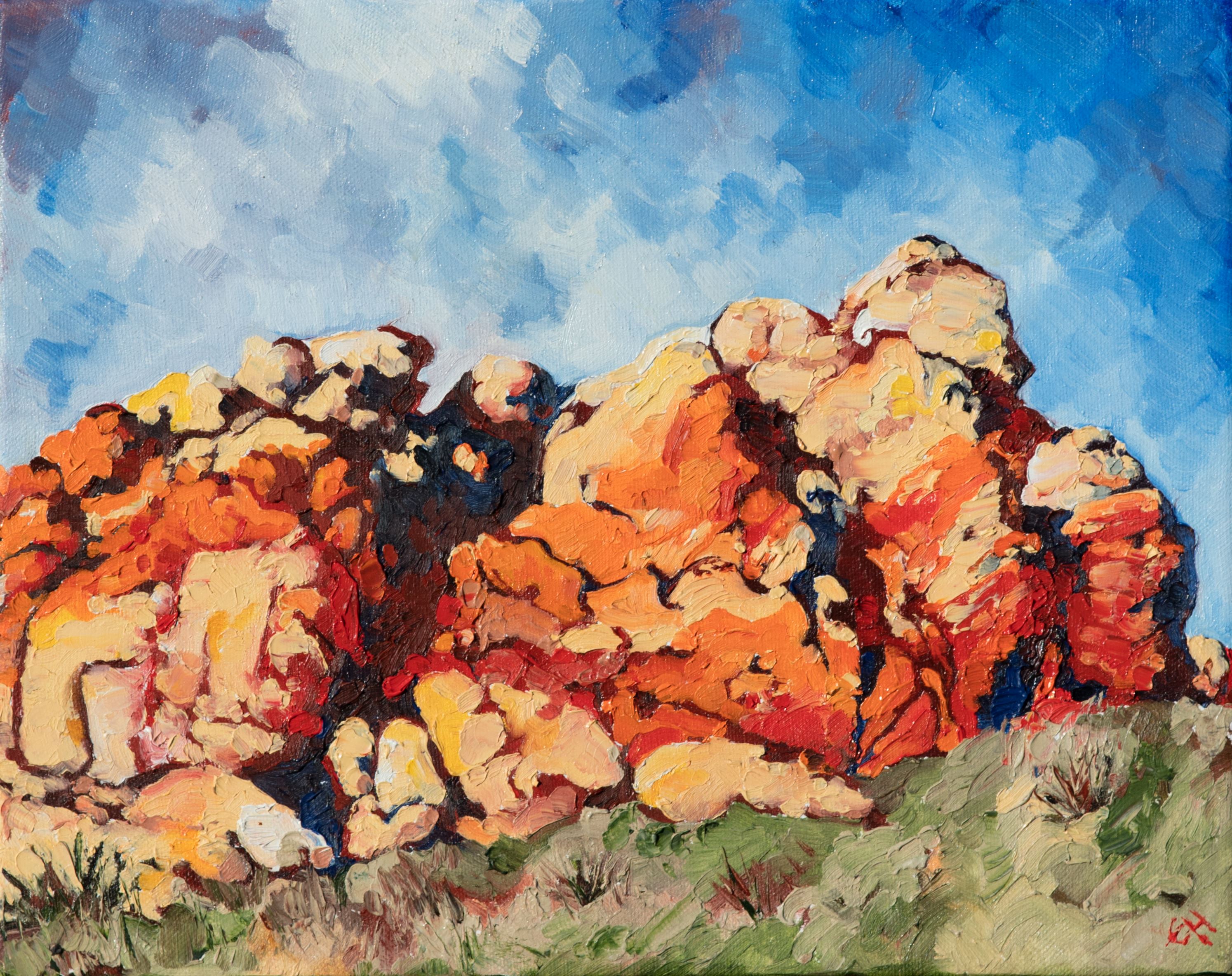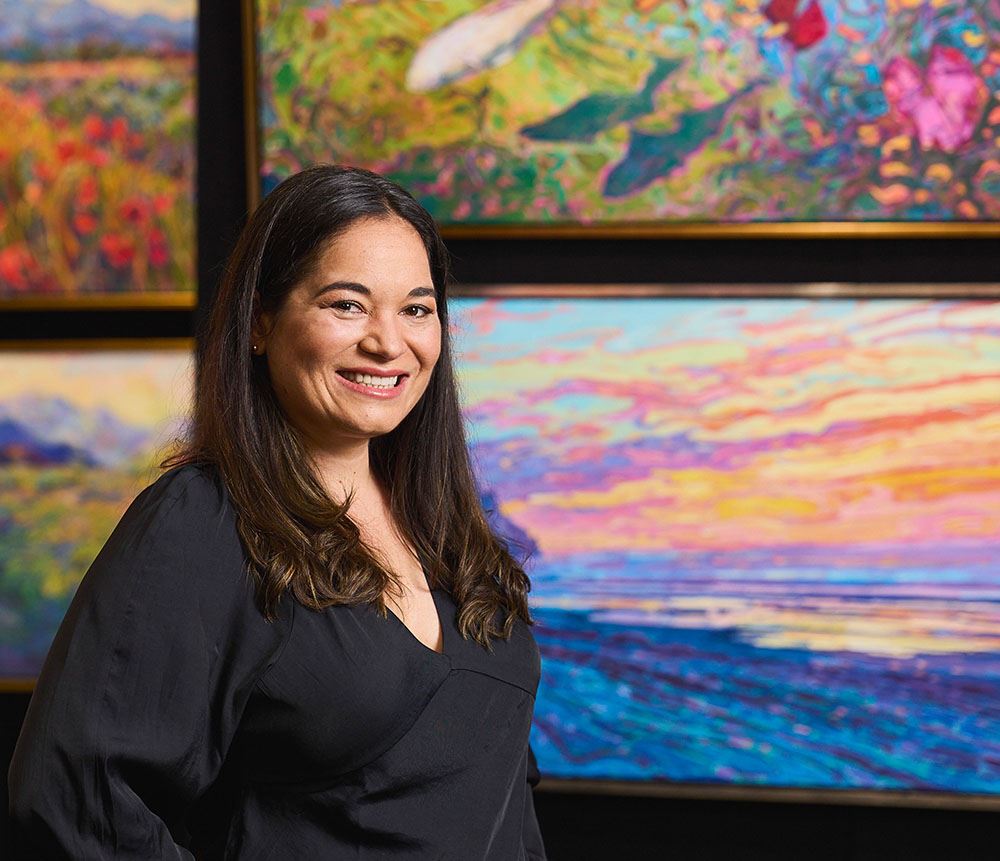
Code EARTH15 applied for 15% off!

Subtotal
$0
U.S. Shipping
FREE
Saved for Later
Shopping Cart

Code EARTH15 applied for 15% off!

Subtotal
$0
U.S. Shipping
FREE
Saved for Later
Looking back almost twenty years ago to what I consider the birth of Open Impressionism, I can hardly recognize the young woman who had just moved to Las Vegas with everything she owned loaded up in the back of her pickup truck. Vegas, with its flair for the unexpected, dealt me several hands of fate that reshuffled my life forever.
I remember arriving at my new Vegas apartment late on a Friday night, only to find the water and electricity had been turned off and wouldn’t be restored until the following week. I had no idea that these words (which caused me to break down crying in that dark alleyway off Flamingo Road) would, in fact, be opening a whole new world and pathway in my life.
Sitting in my truck, unsure of what to do, I realized I couldn’t check into a hotel with all my belongings tied down in the back of my pickup. I didn’t know a single soul in the area, and in that moment of frustration and uncertainty, inspiration struck–I would find a campground! That way I could enjoy some nature, while keeping an eye on everything I owned. I opened my Thomas Guide (yes, this was before iPhones) and found the nearest campground–Red Rock Canyon.
I had decided earlier that with this move to a new city full of fresh possibilities, I would start creating one painting a week just to see where my art would take me. I had been told enough times that it was “too hard to make a living as an artist” --and I believed it--but I just wanted to paint again. I missed the sensual texture of oil paint beneath my brush, the smell of linseed oil, and the endless hope of creating magic from a blank white canvas.
So, the next morning, waking up before dawn in the campground, I dug out my paints and easel (which, of course, I had in the back of my pickup along with everything else). In the gray light of dawn, I hiked to the top of a dusty hill and looked out across the desert to see what I could see. This was my first glimpse of Red Rock Canyon and the moment that truly started me on my career as a painter. I was struck dumb by the rainbow-sherbet-colored mountains as the first rays of dawn illuminated them with magnificent color. I took out my brightest cadmium colors and completed a plein air painting then and there. I worked quickly to capture the colors before they faded, and I laid my brush strokes side by side, without layering, so the colors wouldn’t get muddy. The painting came out easily, naturally, and I felt too inspired to care if my painting was good or not.

Red Rock Nevada by Erin Hanson, 2006
Returning to the campsite later that morning, the second “hand of fate” intervened. My camping neighbors were a group of professional rock climbers who had just moved to Vegas from New York to climb Red Rock Canyon. They asked me if I had ever been climbing before (I said no), and they asked if I wanted to go climbing today (I said yes).
I spent that day exploring the very cliffs I had painted that morning, up close and personal. The experience was transformative. I was immediately addicted to the adrenaline rush and technical challenge of rock climbing. By the time Monday arrived, we had all decided to move in together to a bigger apartment close to Red Rock Canyon, and I left that dark alleyway on Flamingo Road behind for good.
I never set out to become a famous painter or to develop my own style of painting. Those early years in Las Vegas were spent struggling to figure out how to make my paint do what I wanted it to do. Every time I finished a painting, I would try to figure out how I could have done it better. By trial and error, week by week, I tested out different colors, compositions, and painting techniques. Sometimes, a painting would turn out exactly as I had pictured it first in my head, and those ‘eureka’ moments became milestones in my development of Open Impressionism.
One breakthrough came when I was painting over an old painting I didn’t like, and I decided to paint directly over the sanded-down surface instead of covering it first with white gesso. I realized that by using a colored underpainting, I didn’t have to match up my brush strokes so carefully to cover all the white canvas–I could be looser and more fragmented in my painting strokes, allowing the underpainting to become part of the finished work. The next painting I started, I covered my canvas with a thin layer of brightly colored oil paint first, toning my canvas so I wasn’t working on a pure white surface. I fell in love with this effect, and it became a hallmark of my style.
In the same way, I developed the habit of premixing every color that would appear in the painting before I picked up a brush. This solved my frustration of trying to blend color on the canvas and creating a sloppy pile of mud. By pre-planning my paintings as much as possible in advance, I could be freer and looser when painting, getting each stroke right the first time instead of changing and blending my brush strokes after they landed on the canvas. This technique produced a result that resonated with how I wanted to capture the beauty and light of nature.
Painting by painting, I developed my voice. My only measure of success became, “Does this painting match the vision in my head?” It took 400 paintings before I could achieve this goal two out of ten times. By 1,000 paintings, I was batting five out of ten. Now, at 3,000 works completed, I can create the picture I aim for in nine out of ten paintings—but I am still learning and improving with each new creation.
As I reflect on my journey, it’s clear how pivotal a few key moments were in shaping my path. If that apartment on Flamingo Road had been ready, I might never have discovered the landscapes that now define my work. Perhaps I would have struggled with cityscapes, lost my passion, and abandoned painting altogether. Instead, I found a way to blend my two greatest loves—nature and art—into a fulfilling career. Every stroke of paint reminds me of that serendipitous turn of events, and I’m profoundly grateful for the unexpected path that led me here.

About Erin
ERIN HANSON has been painting in oils since she was 8 years old. As a teenager, she apprenticed at a mural studio where she worked on 40-foot-long paintings while selling art commissions on the side. After being told it was too hard to make a living as an artist, she got her degree in Bioengineering from UC Berkeley. Afterward, Erin became a rock climber at Red Rock Canyon, Nevada. Inspired by the colorful scenery she was climbing, she decided to return to her love of painting and create one new painting every week.
She has stuck to that decision, becoming one of the most prolific artists in history, with over 3,000 oil paintings sold to eager collectors. Erin Hanson’s style is known as "Open Impressionism" and is taught in art schools worldwide. With millions of followers, Hanson has become an iconic, driving force in the rebirth of impressionism, inspiring thousands of other artists to pick up the brush.